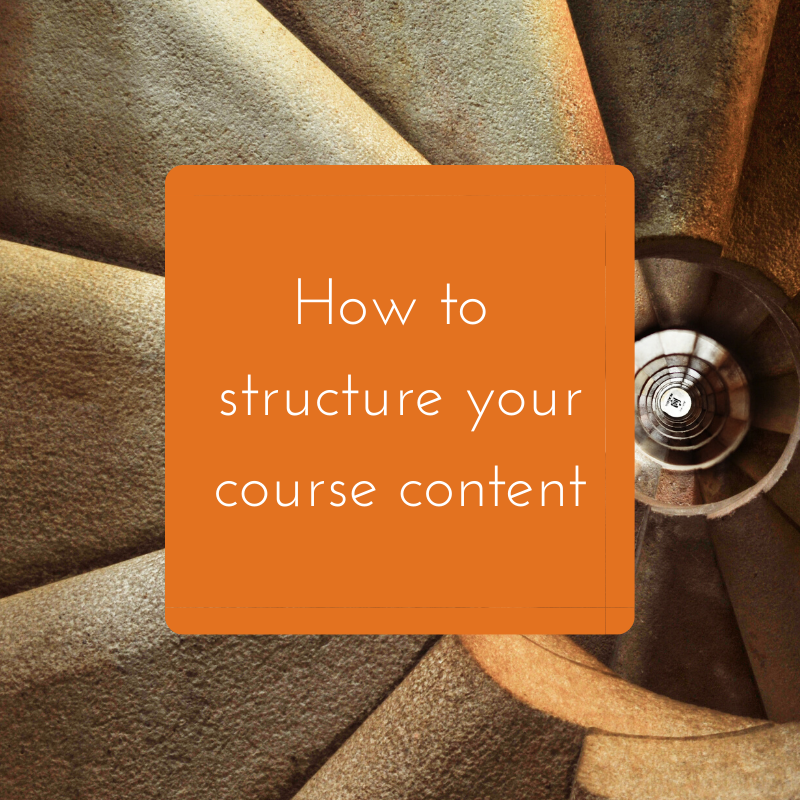What’s the difference between just content, and a course?
Well, quite a few things.
Great structure (which we will cover here), along with support, facilitation, and a feedback cycle (which we’ll be talking about at a later date.)
The thing is, you don’t have to be a course creator, to know what makes a good course and a bad course. You simply draw from past experience.
I’m sure you’ve sat through a course before, and found it the most valuable learning experience…
And I’m sure you’ve sat through a course before, and thought that was several hours of your life that you are never getting back.
You can make a list of the things that made the great course great, and the things that made the bad course bad (in fact, you should, it’s valuable as part of your development process).
And I have no doubt, that somewhere in there will be
Good course = content was clearly laid out, easy to follow and easy to understand
Bad course = content was all over the place, hard to follow along, confused
You might even have experienced it in other situations.
You’ve start reading a blog or a book… Part of you knows that there’s probably some good information in there somewhere, but you just can’t follow along. It jumps all over the place, you find yourself re-reading big blocks, or flicking backward and forward.
You don’t get very far through it before you close it and move on.
So, if structure is that important, what do you need to know to structure your course?
How to structure your course
To start with, think about the 3 main components to your course.
It’s important to think about how all three fit together (most people spend all their time on the modules in the middle, which gives them great content, but not such a great experience).
Welcome Section
This is the part of the course they should be able to access when they first sign up, even if the course hasn’t started yet.
This is where you lay the groundwork for a great learning experience. You set boundaries and expectations, you give guidance and you make the feel like they are already part of something amazing.
This is even more important if they’ve purchased a little in advance of the start date, as a well formed welcome area will stop them getting cold feet about their purchase.
In the welcome section you should:
- Give an overview of the upcoming content
- Explain how it all works (how will they access the content, where can they get the live calls)
- Give important dates and links
- Link to a support group, or an email they can contact if they get stuck
- Introduce yourself (keep this brief, they trusted you enough to press purchase already)
- Explain any boundaries (eg your hours of availability, what can and can’t be discussed on calls or in the group).
The Content
This is the part where all of your learning material goes. You want to make sure that you’ve broken your content down into modules, or topics (think of these a bit like chapters in a book). Then break each of the modules down into tiny, bite sized chunks. (More on this process below)
The Wrap up
This is the end of the course, but that doesn’t mean it’s not important. The wrap up at the end of the course is a key part of building real change and raving fans.
In this section you can
- congratulate your participants on how far they’ve come
- you can assess their progress
- Issue certificates or awards
- you can ask for feedback and testimonials
- you can guide them on where to go and what to do next. (ongoing support programs, groups to join etc)
Rather than just coming to an abrupt stop, or just leaving the group open with no clear ending, you want the end of your course to feel like a big, warm group hug.
Laying out your content
Ok, back to that middle bit of your course – the bit with all of the content.
One of the biggest mistakes people make when creating their own course is trying to include too much content.
The next biggest mistake I see, is not breaking it down into small enough piece.
To start, you want to break your course down into topics (often called modules). Think of these like chapters in a book. All of the information in one topic should be related to each other.
Then you want to break all of the content in that topic down into tiny little bite-sized chunks.

These chunks should be easily consumable in just one sitting.
That means if they’ve got 15min to sit and get through the next bit of your course, you want them to be able to easily log in, access the content, watch the video and read the stuff, and even implement in that time if possible.
In reality, that doesn’t give you very long to get the key messages across, and is even more reason why you need to focus on including the really important stuff in your course, and minimising the filler content.
Overwhelm and a feeling of falling behind comes from there being too much content, or when they think that they just won’t be able to get through all of the content in the time they have available to them. So keep the chunks short and sweet.
Long story short…
Their time is valuable, just like yours.
The aim is to break your content down into pieces that make the biggest impact, in the shortest time possible.
Then we can use any extra time for implementation, support and feedback.

